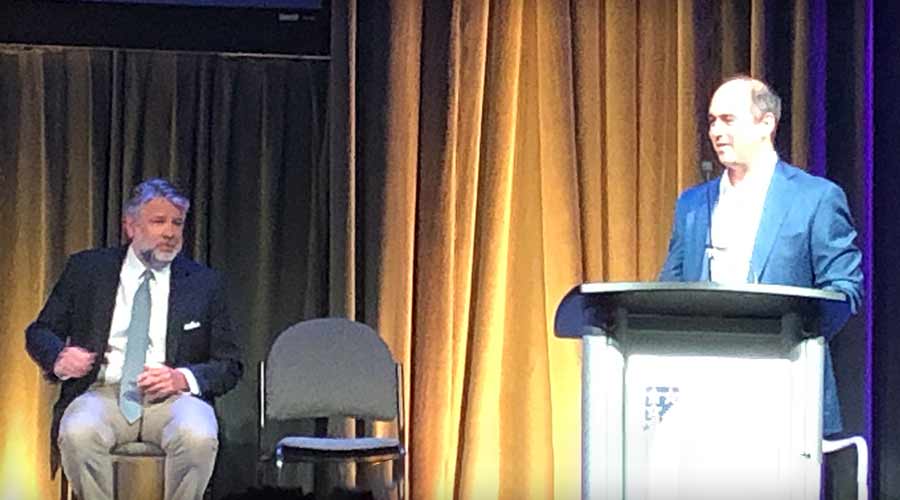Baker at ASLRRA conference: More positives than negatives for short-line sector
4/11/2023
By Jeff Stagl, Managing Editor
American Short Line and Regional Railroad Association (ASLRRA) leaders had a few encouraging things to share about the organization’s 110th annual convention as the general session started on April 3.
For one, the event held April 2-4 in New Orleans attracted 1,854 attendees, the second-highest count in the conference’s history. That figure trails only the record attendance established at the ASLRRA’s centennial convention held in Atlanta in 2013.
The 2023 convention also marked record sponsorship — with 15 diamond, 42 platinum, five gold, 11 silver and seven bronze sponsors — and an extraordinary number of breakout sessions at 35.
Plus, ASLRRA leaders mentioned how Iowa Northern Railway is registering such explosive revenue growth, the Class III railroad might soon meet the threshold of a Class II railroad.
That smattering of feel-good information led into an address by ASLRRA President Chuck Baker, who also talked about several promising developments, but some discouraging ones, as well. None bigger than the public’s and media’s recent perception that rail safety is questionable — an aftereffect of Norfolk Southern Railway’s early February derailment in East Palestine, Ohio.
That non-gift that keeps giving followed the near strike at major railroads in the fall. Fortunately, a strike was averted by labor agreements that address some of rail workers’ quality-of-life concerns, such as more predictable schedules and paid sick leave, said Baker.
All in all, it’s been a trying period for railroads of late, he said.
 Baker (at the lectern) was joined on stage by Genesee & Wyoming Railroad Services Inc. EVP of Global Corporate Development Matt Walsh, who was installed as the ASLRRA’s next chairman during the general session on April 3. Jeff Stagl
Baker (at the lectern) was joined on stage by Genesee & Wyoming Railroad Services Inc. EVP of Global Corporate Development Matt Walsh, who was installed as the ASLRRA’s next chairman during the general session on April 3. Jeff Stagl “I tried to come up with the right word to describe it. I thought of ‘wild,’ but that didn’t seem right. Then, ‘terrible,’ but not so much,” he said. “And then I came up with ‘tumultuous.’ It’s been a tumultuous year.”
Railroad developments began to become front-page news late last year, so much so the “mom clipping index” hit maximum overdrive, Baker said. The index refers to how a mother tends to clip every piece of printed information referencing her children.
Then came East Palestine, and what Baker characterized as a gusher of coverage on rail industry issues, such as safety.
“That made the mom clipping index from fall look like nothing,” he said.
Suddenly, a high number of “armchair railroad experts” began to surface and the damage was done — six pieces of federal legislation addressing rail safety have been introduced and many new or reinterpreted rail rules have been proposed, said Baker.
For short lines, many politicians aren’t distinguishing large railroads from small ones when it comes to safety concerns. Therefore, when it comes to drafting restrictive rules or new legislation that increases crew size or includes other troubling provisions, it’s vital that congressfolk “match the pen to the purpose,” Baker said.
However, there are some encouraging things happening in Washington, D.C., for short lines. The biggest one is the healthy federal grant funding for the Consolidated Rail Infrastructure and Safety Improvements (CRISI) Program, which in part helps fund freight-rail projects designed to improve safety, efficiency and reliability.
In August or September, the U.S. Department of Transportation should announce the recipients of the historic $1.4 billion in grant funding for fiscal-year 2022, which hopefully will include many short lines and their projects, said Baker. The total FY22 grant amount was over four times higher than FY21’s level.
The notice of funding opportunity for FY23 CRISI grants is expected to occur in late fall, and the total grant amount should soar to $2.5 billion to $3 billion because two fiscal years’ worth of grant monies are being combined, said Baker.
“If you haven’t been thinking about going after a CRISI grant, you should clear your mind and do it. This is a huge opportunity for all,” he told attendees.
The ASLRRA also plans to lobby hard to prompt a much-needed change to the Section 45G tax credit for short lines, which helps fund infrastructure improvements. Now enacted permanently, the tax credit has been in place since 2004.
But one crucial aspect of Section 45G hasn’t changed in those nearly 20 years: the $3,500 cap on each mile of track owned by a regional or short line.
That figure is quite outdated, so the association aims to increase the cap to $5,000 or so, Baker said.


